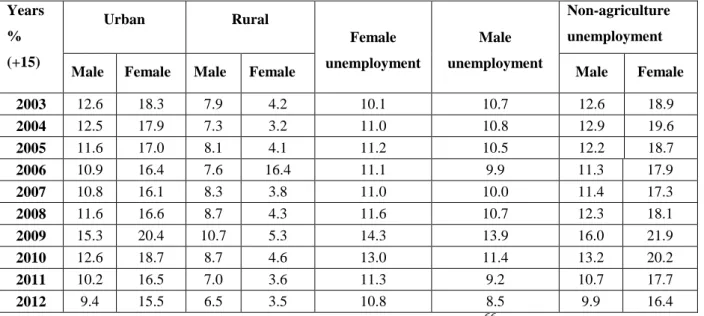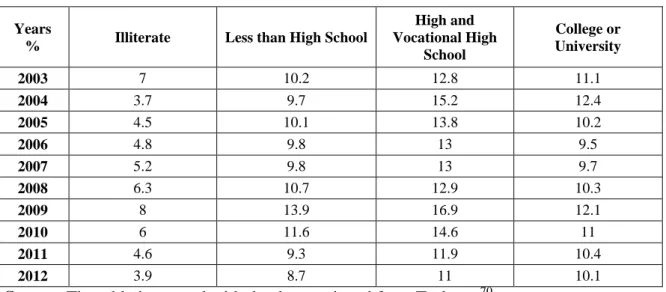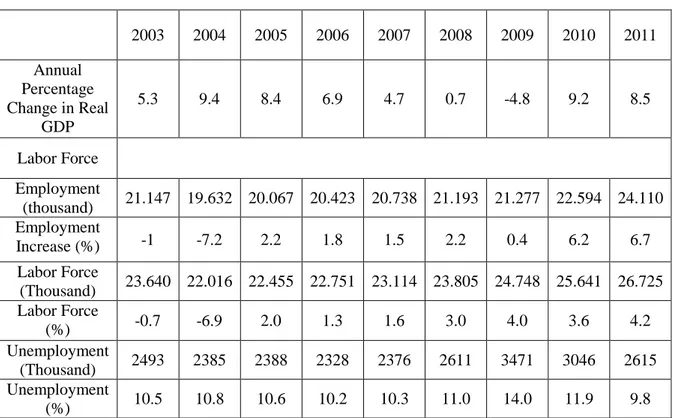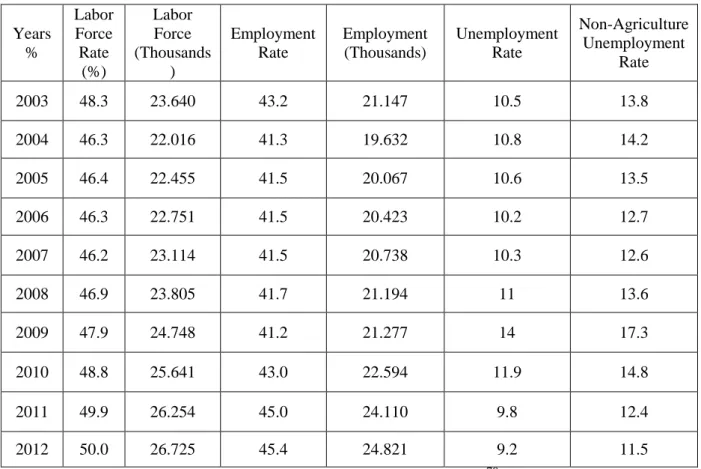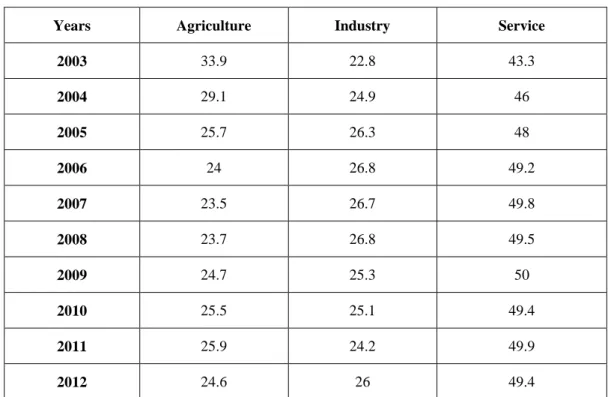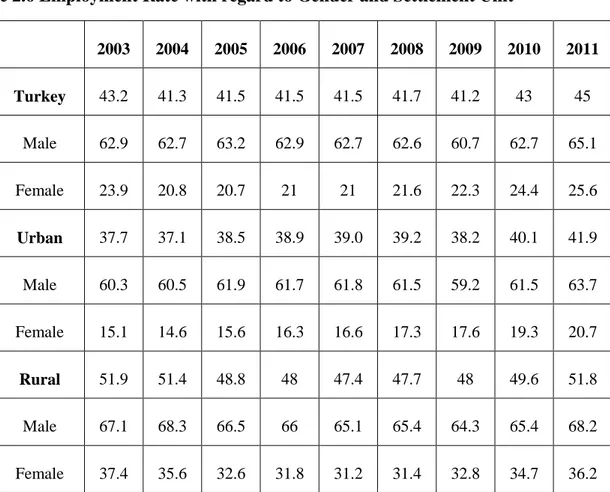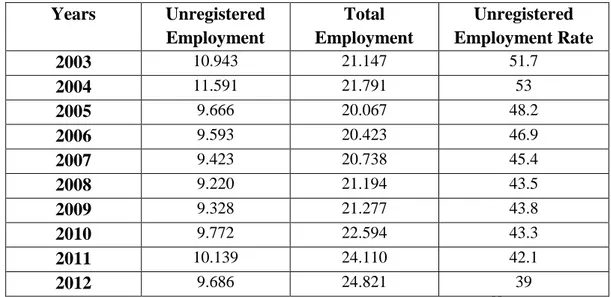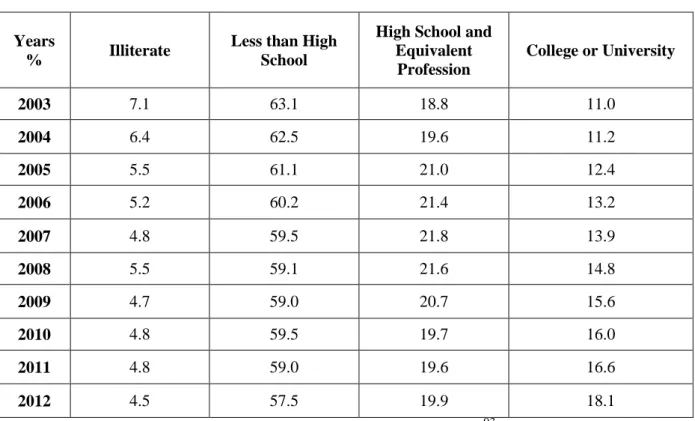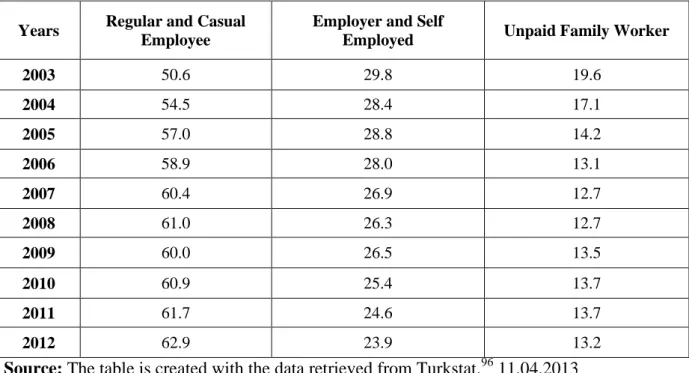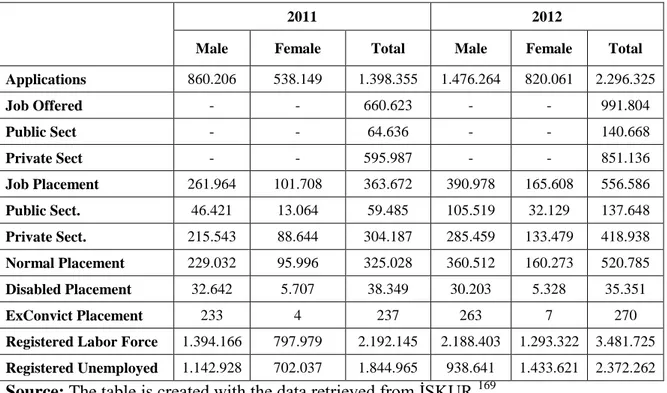Ömür UÇAR
THE ROLE OF ACTIVE LABOR MARKET POLICIES APPLIED BY İŞKUR (TURKISH EMPLOYMENT AGENCY) IN STRUGGLING WITH UNEMPLOYMENT
Joint Master’s Programme European Studies Master Thesis
Ömür UÇAR
THE ROLE OF ACTIVE LABOR MARKET POLICIES APPLIED BY İŞKUR (TURKISH EMPLOYMENT AGENCY) IN STRUGGLING WITH UNEMPLOYMENT
Supervisors
Prof. Dr. Akın AKSU, Akdeniz University Dr. Manfred WANNÖFFEL, Hamburg University
Joint Master’s Programme European Studies Master Thesis
Sosyal Bilimler Enstitüsü Müdürlüğüne,
Ömür UÇAR’ın bu çalışması jürimiz tarafından Uluslararası İlişkiler Ana Bilim Dalı Avrupa Çalışmaları Ortak Yüksek Lisans Programı tezi olarak kabul edilmiştir.
Başkan : Prof. Dr. Harun GÜMRÜKÇÜ (İmza)
Üye (Danışmanı) : Prof. Dr. Akın AKSU (İmza)
Üye : Dr. Manfred WANNÖFFEL (İmza)
Tez Başlığı : İşsizlikle Mücadelede İŞKUR’un Uyguladığı Aktif İşgücü Politikalarının Rolü
The Role of Active Labor Market Policies Applied by İŞKUR (Turkish Employment Agency) in Struggling with Unemployment
Onay : Yukarıdaki imzaların, adı geçen öğretim üyelerine ait olduğunu onaylarım.
Tez Savunma Tarihi : 19/12/2013 Mezuniyet Tarihi : 23/01/2014
Prof. Dr. Zekeriya KARADAVUT Müdür
LIST OF TABLES ... iv LIST OF ABBREVIATIONS ... v ÖZET ... vi SUMMARY ... vii INTRODUCTION ... 1 CHAPTER 1 UNEMPLOYMENT 1.1 Definitions of Unemployment ... 3 1.2 Types of Unemployment ... 3 1.2.1 Voluntary Unemployment ... 3 1.2.2 Involuntary Unemployment ... 4 1.2.3 Hidden Unemployment ... 4 1.2.4 Structural Unemployment ... 5 1.2.5 Frictional Unemployment ... 5 1.2.6 Seasonal Unemployment ... 6 1.2.7 Technological Unemployment ... 6 1.2.8 Cyclical Unemployment ... 6 1.3 Costs of Unemployment ... 7
1.4 Theoretical Approaches to Unemployment ... 8
1.4.1 Keynesian Approach... 8
1.4.2 Neoclassical Approach ... 9
1.4.3 Neoliberalism ... 11
1.4.4 Neoliberal Policies Against Unemployment ... 13
CHAPTER 2 STRUCTURE OF TURKISH LABOR FORCE AND ITS FEATURES 2.1 Unemployment in Turkey ... 16
2.1.1 Development Process of Unemployment ... 17
2.1.2 Unemployment with Regard to Settlement Unit, Gender and Age ... 18
2.1.3 Unemployment Rate with Regard to Education ... 19
2.2 The Correlation Between Growth and Unemployment ... 20
2.4 Employment in Turkey ... 23
2.4.1 Structure of Employment with Regard to Sectors ... 23
2.4.2 Structure of Employment with Regard to Gender and Settlement Unit ... 25
2.4.3 Unregistered Employment ... 26
2.4.4 Structure of Employment with Regard to Education Level ... 27
2.4.5 Distribution of Employment by Status ... 28
2.5 Other Main Problems in Turkish Labor Market ... 29
2.5.1 Labor Costs ... 30
2.5.2 Overworking ... 30
CHAPTER 3 ACTIVE LABOR MARKET POLICIES 3.1 Reasons of Being Popular of Active Labor Market Policies ... 33
3.2 Subsidised Employment ... 34
3.3 Labor Market Training Programs ... 37
3.3.1 Labor Training Programs And Its Importance ... 37
3.3.2 Economic Reasons of Applying Labor Training Programs... 38
3.3.3 Features of Successful Labor Training Programs... 39
3.3.3.1 Training Programs Should Conform with Developing Sectors ... 39
3.3.3.2 Training Programs Should Be Arranged For Needs of Unemployed ... 39
3.3.3.3 Training Programs Should Target Disadvantaged Groups ... 40
3.4 Direct Job Creation in the Public Sector ... 40
3.5 Job Search Assistance ... 42
CHAPTER 4 ACTIVE LABOR MARKET POLICIES IN TURKEY 4.1 Generally Active Labor Market Policies in Turkey ... 45
4.2 Employment Policies in Development Plans... 45
4.2.1 Eighth Five Year Development Plan 2001-2005 ... 45
4.2.2 Ninth Development Plan 2007-2013 ... 46
4.3 Turkish Employment Agency (İŞKUR) and Its Activities with Regard to Active Labor Market Policies ... 47
4.3.1 Employment Services ... 49
4.3.2 Labor Training Programs... 50
4.3.2.2 On The Job Training Programs ... 51
4.3.2.3 Work Programmes for Public Benefit (WPPB) ... 52
4.3.2.4 Entrepreneurship Training Programs... 53
4.3.3 Job Counselling Services of İŞKUR ... 54
4.3.4 Employment Subsidies ... 56
CONCLUSION ... 58
BIBLIOGRAPHY... 63
CURRICULUM VITAE ... 74
LIST OF TABLES
Table 2.1 Unemployment Rate with Regard to Settlement Units and Gender ... 18
Table 2.2 Unemployed Ratio By Educational Status and Periods ... 20
Table 2.3 The Correlation Between Growth and Unemployment ... 21
Table 2.4 Labor Force Situation Of Non-Institutional Population ... 23
Table 2.5 Structure of Employment with Regard to Sectors ... 24
Table 2.6 Employment Rate with regard to Gender and Settlement Unit ... 26
Table 2.7 Unregistered Employment Rate ... 27
Table 2.8 Education Level Of Employment ... 28
Table 2.9 Distribution Of Employment Rate By Status ... 29
Table 4.1 Employment Services of İŞKUR ... 49
Table 4.2 Labor Training Course Activities of İŞKUR ... 53
LIST OF ABBREVIATIONS
ALMPs Active Labor Market Policies
EU European Union
GDP Gross Domestic Product
ILO International Labour Organisation IMF International Monetary Union
IPJE Institution of Providing Jobs and Employees İŞKUR Türkiye İş Kurumu (Turkish Employment Agency)
OECD Organization for Economic Cooperation and Development
KOBİ Küçük ve Orta Boy İşletmeler (Small and Medium sized Enterprises) KOSGEB Küçük ve Orta Ölçekli İşletmeleri Geliştirme ve Destekleme İdaresi
Başkanlığı (Small and Medium Industry Development Organization) SPO Turksih State Planning Organization
TUİK Türkiye İstatistik Kurumu (Turkish Statistics Institute) WPPB Work Programme for Public Benefit
ÖZET
İŞSİZLİKLE MÜCADELEDE İŞKUR’UN UYGULADIĞI AKTİF İŞGÜCÜ POLİTİKALARININ ROLÜ
İstihdamın boyutu ve işsizliğin yapısı ekonomik gelişmişliğin ve sosyal kalkınmanın önemli göstergeleri olarak görülmektedir. Hiç şüphesiz ki, neoliberal ekonomi politikalarının benimsendiği 1980’lerden beri, işsizlik hem gelişmiş hem de Türkiye gibi gelişmekte olan ülkelerde en temel problemlerden birisidir. Son on yıl içinde, ekonomi de yaşanan ortalama yüzde 5’lik büyümeye rağmen, bu iş gücü piyasasına çokta olumlu yansımamıştır. İstihdamsız büyüme ve yüksek işsizlik oranları OECD ülkeleri ve Türkiye’de, neoliberal ideoloji çerçevesinde (arz-yönlü politikalar temelinde) aktif iş gücü piyasası politikalarının ön plana çıkmasına neden olmuştur. Ancak Türkiye’de işsizlikle mücadele de bu politikaların etkinliğinin ve önemini gösteren çok az bilimsel çalışma vardır. Dolayısıyla, bu çalışmanın Türkiye’de uygulanan aktif iş gücü piyasası politikalarının etkinliği konusundaki tartışmalara bir katkıda bulunması amaçlanmaktadır.
Bu yüksek lisans tezinin çerçevesi, Türk iş gücü piyasasını ve işsizlikle mücadele de İŞKUR tarafından uygulanan aktif iş gücü piyasası politikalarını incelemektir. Bu çerçeve de çalışmanın amacı ‘Türkiye de son on yılda İŞKUR tarafından uygulanan aktif iş gücü piyasası politikaları başarılı olmuş mudur?’ sorusuna cevap aranacaktır.
Anahtar Kelimeler: İşsizlik, Neoliberalism, Türkiye’de İşgücü Piyasası, Türkiye İş Kurumu
SUMMARY
THE ROLE OF ACTIVE LABOR MARKET POLICIES APPLIED BY İŞKUR (TURKISH EMPLOYMENT AGENCY) IN STRUGGLING WITH
UNEMPLOYMENT
Employment size and unemployment structure have been admitted as signals of economic development and social progress. There is no doubt that the unemployment has been one of the main problems for both developed countries and for developing countries such as Turkey since 1980s in which neoliberal policies have been adopted. Although there is average about 5 per cent growth in economy in the last decade, this has not reflected to labor market so positively. Jobless growth and high unemployment rates in OECD countries and Turkey have led to come to forefront of Active Labor Market Policies in the framework of neoliberal ideology. However, there are very few researches showing how important and active these kinds of policies in Turkey. For this reason, the aim of this study is to contribute to discussions about effectiveness of Active Labor Market Policies in Turkey.
The framework of this postgraduate thesis is to analyze the policies which are applied by İŞKUR on Turkish Labor Market and fighting against unemployment. Within this scope, the aim of this study is to seek an answer whether Active Labor Market Policies applied by İŞKUR for last decade are successful or not.
Keywords: Unemployment, Neoliberalism, Turkish Labor Market, Turkish Employment
Unemployment problem is one of the main problems of societies, which have been concerning the societies since hunter and collector tribe. The most important development, which caused serious unemployment problem in the world, is industrial revolution in the 18th century. After this revolution, almost every country faced unemployment problem. While, until Great Depression in 1929, unemployment was thought as involuntary action, after this date, it was realized that it could occur as involuntary. Keynesian policies came into prominence on the struggle with unemployment in the period between 1945 and 1975, called as the golden age of welfare states, full employment was provided in welfare states. However, Keynesian economy could not find a remedy for economic crisis in 1970s and thus unemployment became a problem not only in developing countries or underdeveloped countries but also in developed countries.
Therefore, the tendency of neoliberal policies increased and consequently the fundamental changes were made in economic and social structure. In this period, by implementing contractionary macro-economic policies, inflation was aimed to get under control but the contractionary macro-economic precautions (such as; downward flexibility of labor wages, deregulation of labor market, extend of free market agreements, liberation of financial market, privatization and reduce of public expenditure) increased unemployment much more rather than solving this problem.
Due to these factors, unemployment rate increased in OECD countries rapidly. While in 1970s unemployment rate was average about 3 per cent in OECD countries, it occurred 8.0 per cent in 2012. Therefore, active labor market policies (ALMPs) which have been applying in many OECD countries since 1960s have become one of the most important issues of their agenda.
ALMPs generally aim disadvantaged people which are unqualified and uneducated, to gain qualifications demanded by labor market and so to reduce unemployment rate. In addition, another main goal of ALMPs is to reduce labor cost of employers in parallel with neoliberal policies. In this framework, there is a considerable amount of spending. This considerable spending for ALMPs make ALMPs a current issue whether ALMPs satisfy the expectations or not. In this context, although there are various studies, the effects of ALMPs on employment is ambiguous. The effects of ALMPs can be different with regard to species of
policies, applied economic and social structure, targeted group and etc. For this reason, it is impossible to generalize the ALMPs’ effects.
On the other hand, unemployment rate in Turkey has increased in parallel with world market conditions day by day. Therefore ALMPs remains on the Turkish Governments agenda. However, unfortunately the academic studies about effects of ALMPs in Turkey have remained incapable therefore; their effects are not known exactly. Insufficient academic studies and knowledge about applications, purposes and effects of ALMPs have necessitated to study about this issue.
Generally, the purpose of this thesis is to analyze ALMPs, its scope, purpose, applications in Turkey, to show the roles of these policies on the issues of reducing unemployment and increasing employment and so, to determine actions to be taken in Turkey.
Within this context, in the first chapter of thesis, the unemployment, types of unemployment, cost of unemployment will be analyzed. The end of the first chapter, the theoretical background of unemployment will be discussed in the context of Keynesian, Neoclassical theory and neoliberal ideology. In the second chapter, the Turkish Labor Market its feature, advantage and disadvantage will be explained with the help of tables. In the third chapter, Active Labor Market Programs, their applications and effects will be examined and then in the last chapter, the ALMPs applied by İŞKUR (Turkish Employment Agency) and its effects to Turkish labor market will be evaluated and to be more effective of ALMPs, there will be submitted some advices.
As a result of this study, the Active labor market programs, applied by İŞKUR, remained incapable to reduce unemployment in Turkey and it failed to reduce structural unemployment. As a matter of fact that the trustworthy of ALMPs in which the high unemployment rate and low labor cost has been putted in order to solve or decrease the unemployment is open to the debates and criticism.
CHAPTER 1
1 UNEMPLOYMENT
1.1 Definitions of Unemployment
Unemployment is a very serious trouble for both developed and developing countries and its conclusions concern a lot of sciences as it can affect the large part of society. That is why unemployment has a lot of definitions. In the most general sense, unemployment is;
“Unemployment is defined as a situation where someone of working age is not able to get a job but would like to be in full time employment”.1
Unemployment occurs when labor force which is prerequisite for production cannot be used2. According to Gök, unemployment means that labor force which is essential element of production cannot be used in full capacity.3 In other words, unemployment causes waste of labor force. According to Özgüven who defines unemployment technically, unemployment is difference between labor force and number of employment.4
As it can be understood above, according to the common feature of these definitions, unemployment occurs if people cannot find any job although they are able to work, willing to work or seeking for a job.
1.2 Types of Unemployment
Due to the fact that there are a lot of various reasons of unemployment, there are a lot of different types of unemployment and they can be classified by age, level of education, gender, duration unemployment, geographical position and its reasons.
1.2.1 Voluntary Unemployment
Bosworth, Dawkins and Stromback described individuals as voluntarily unemployed as;
1 Tejvan Pettinger , Definition of Unemployment (2010)
<http://www.economicshelp.org/blog/2247/unemployment/definition-of-unemployment/> [accessed 26 August 2013].
2 Mustafa Kemal Biçerli., İşsizlikle Mücadelede Aktif İstihdam Politikaları, (Eskişehir: Anadolu Üniversitesi,
2004), p. 1.
3 Mehmet Gök., İşgücü Piyasası ve Kobiler, (Ankara: Roma Yayınevi, 2004), p.34. 4
“if they choose not to work rather than take available jobs for which they are qualified, because wages or other working conditions are less attractive than the option of not working”.5
From this definition, the reasons of voluntary unemployment can be monetary and individuals. However, if they agree to work on the level of prevailing wage, it is possible to find a job. Especially, neoclassic economics assert the unemployment in market as voluntary.
1.2.2 Involuntary Unemployment
By the same token, involuntary unemployment is defined by Bosworth, Dawkins and Stromback as it occurs when;
“individuals cannot obtain work even if they prepared to accept lower real wages or poorer conditions than similarly qualified workers who are currently in employment”.6
This kind of unemployment occurs in countries developed division of labor and work specialization.
On the other hand, classical economists and neoclassical economists do not accept this kind of unemployment and they claim that involuntary unemployment can be prevented if unemployed accept to work with lower real wages.7
1.2.3 Hidden Unemployment
Hidden unemployment is a kind of unemployment of the potential workers not reflected to the unemployment statistics. Although they have jobs, these kinds of people have no contribution to production.8 Due to this, hidden unemployment occurs. According to Özgüven, the reasons of hidden unemployment are on different grounds in developed countries and developing countries. In developing countries such as Turkey, the reasons are undercapitalization being continuous and structural. Besides, due to the fact that population increase is more than speed of capital increase, hidden unemployment gains continuity in these countries. On the other hand, in developed countries hidden unemployment arises from
5 Derek L. Bosworth, Peter J. Dawkins, Thorsten Stromback, The Economics of the Labour Market (London:
Financial Times/Prentice Hall, 1996), p. 409.
6 Ibid, p. 409
7 Tevfik Pekin, Makro Ekonomi (İzmir: Zeus Kitapevi, 2007), p. 107.
8 Kemal Yıldırım and Doğan Karaman, Makro Ekonomi (Eskişehir: Eğitim, Sağlık ve Bilimsel Araştırma
lack of demand but this situation is temporal.9 Briefly, in hidden unemployment there is non-productiveness both in developed and developing countries.
1.2.4 Structural Unemployment
According to Borjas, who has valuable studies about labor economics, in structural unemployment, there is no balance between the total numbers being supplied and demanded in the labor market. While some sectors in the economy are growing, other sectors are declining. Therefore, labor force will move to the growing sectors. But this accordance of movement can take time or this accordance cannot occur completely. So, existing unemployment in these situations is named as structural unemployment, in labor economy.10 It can be said that social-economic changes in structure of society and differentiation in applications can cause to structural unemployment.11
In the general sense, the reasons of structural unemployment are economic growth, lack of capital, development in technology and industry and also followed sectorial, industrial and regional policies of government.12 In order to reduce structural unemployment which is generally seen in developing and underdeveloped countries, governments have to provide training programs supplying opportunities to displaced workers to gain skills demanded from them.13
1.2.5 Frictional Unemployment
It is a kind of temporary unemployment arising from immobility of labor or unwillingness of labor to learn new skills14. In this kind of unemployment, employees give up their job to get new jobs having better conditions. Frictional unemployment can occur when the economy is on the balance of full employment.
According to Borjas, frictional unemployment is not a structural problem in labor market, it only causes short time unemployment. Besides, sometimes frictional unemployment is an advantage ‘because the search activities of workers and firms improve the allocation of
9 Özgüven, İşgücü Piyasası ve Kobiler, p. 401.
10 George J. Borjas, Labor Economics, 5th edn (New York: McGraw-Hill/Irwin, 2010), p. 504-505 11
Sabahattin Zaim, Çalışma Ekonomisi, 10th edn (İstanbul: Filiz Kitapevi, 1997), p. 188-189.
12 Mustafa İlker Parasız, 1923'ten Günümüze İktisat ve İstikrar Politikaları (Bursa: Ezgi Kitabevi, 1998), p. 36. 13 Borjas, p.505.
14 Prince Efere, Fighting Unemployment (2004), p.3,
resources’.15
Frictional unemployment can be solved in developing countries with the help of some political precautions taken by governments.
1.2.6 Seasonal Unemployment
This kind of unemployment occurs depending on changes in demand and supply of goods and services due to the seasonal variations.16 Agriculture, construction, building and tourism sectors are affected by seasonal unemployment. In the season of increasing of working facilities, employment rate grows, but when working facilities decline, employment rate decreases.
The reasons of seasonal unemployment change from country to country. While it arises from changes in demand in the developed countries, on the other hand in underdeveloped countries whose economy depends on agriculture, it arises from changes in supply and seasonal productions. This situation emerges from the structure of agricultural production17.
1.2.7 Technological Unemployment
Technological developments in production cause this kind of unemployment. With the developments of technology, machines or more productive methods take place of human labor. This situation can be seen in both developing and developed countries. However, its effects can be so serious in developing countries. On the other hand, developed countries which have technological and technical knowledge capacity can provide new employment opportunity for the unemployed.
With the organizing labor training programs, negative effects of technological unemployment can be reduced.
1.2.8 Cyclical Unemployment
Cyclical unemployment occurs because of the peaks and through of the trade cycle. It happens generally during to the period of economic recession. According to Eyuboglu, the main reason of cyclical unemployment is lack of effective demand.18
15 Borjas, p.504. 16
Efere, Fighting Unemployment, p.1
http://www.bayelsa.org.uk/pdf/bsup-fighting-unemployment.pdf last accessed:(12.02.2013)
17 Zaim, Çalışma Ekonomisi, p. 179
18 Deniz Eyüboğlu, 2001 Krizi Sonrasında İşsizlik ve Çözüm Yolları (Ankara: Milli Prodüktivite Merkezi
It is not possible to say that there is no unemployment when there are increase of investment, employment rate, monetary value and capital efficiency. Because, overproduction increases incomes and when incomes increase more and more, savings increase parallelly; consumption decrease and lack of demand occurs. In this case, investments declines and then cyclical unemployment can emerge.19 Cyclical unemployment can affect many people and its effects can last a long time.
It is a conclusion of capitalist system and this kind of unemployment is generally seen in developed countries. Its effects can be reduced by the help of some economic precautions. According to Borjas, in order to decrease cyclical unemployment, the state has to stimulate aggregate demand and reestablish market balance at the sticky wage.20
1.3 Costs of Unemployment
Unemployment is a very big problem for both developing countries and developed countries in this century and its effects are multiple. It causes economic, psychological, and social costs on the individuals.
Economic Cost of Unemployment; the main economic cost of unemployment is decline of gross national product and losing of skills of unemployed. For instance, according to Turkish Statistical Institute (2012) the number of labor force in Turkey is approximately 27 million and unemployment rate is 9 %. That is to say that there are approximately 2.5 million unemployed in Turkey. In other words, it is loss of production and waste of 2.5 million labor force. In addition to this, due to the unemployment, there can be declines in aggregate income tax of government budget. Besides, many of social developed countries pay for unemployed unemployment compensation and this has been a great loss recently in developed countries. The social cost of unemployment; it is a result of psychological and economic effects. It causes financial difficulty and poverty. When increase of unemployment, in parallel with crime rates, divorce rates and social uneasiness increase.21 According to studies of Hale and
19 Aydın Türkbal, İktisada Giriş. (Diyarbakır: Dicle Üniversitesi, Hukuk Fakültesi Yayınları No: 9, 1993), p.
389-390.
20 Borjas, Labor Economic, p.504.
21 Ali Rıza Sandalcılar, 'İşsizlik Boşanmayı Etkiliyor mu?Bölgesel Panel Nedensellik”', Ege Akademik Bakış,
12.2, (2012), 225, in<http://www.onlinedergi.com/makaledosyalari/51/pdf2012_2_9.pdf> [accessed 20
Sabbagh in England, there is positive relationship between unemployment and crime rates22. Similarly, the study of Cömertler and Kar supports this positive relationship23. In order to reduce social effects of unemployment, as it has been mentioned above, the social developed countries pay for unemployed unemployment compensation.
Psychological disorder because of unemployment is a serious problem not only unemployed people but also people at work who believe job security is not enough for them24. In addition of this unemployment can cause a lack of self-esteem, depression and even suicidal behavior25.
1.4 Theoretical Approaches to Unemployment 1.4.1 Keynesian Approach
Keynesian approach has emerged as a necessity to response to classical theory that was assumed to become a remedy to Great Depression. According to this model created by John Maynard Keynes, capitalism would alive with the state interventions.26
Keynes analyzed operation of an economy in “General Theory” on the concept of sectors-markets. He claimed that it is impossible to provide full employment automatically; therefore, in economic life government intervention is a need to reduce unemployment.
Classical economists claim that unemployment is a permanent problem that occurred because of the labor market rigidity and it could be vanished by flexibilisation of wages.27 However, according to Keynes, nominal wages and prices are sticky and flexible labor market is not a solution to remove unemployment because wage flexibility lead to deflation rather
22
Chris Hale and Dima Sabbagh, 'Testing The Relationship Between Unemployment and Crime: A Methodological Comment and Empirical Analysis Using Time Series Data From England and Wales',Journal of
Research in Crime and Delinquency, 28.4, (1991), 400-417 (p. 401-402).
23 Necmiye Cömertler and Muhsin Kar, 'Türkiye'de Suç Oranının Sosyo-Ekonomik Belirleyicileri: Yatay Kesit
Analizi', Ankara Üniversitesi SBF Dergisi , 62.2, (2007), 38-57 (p. 38), in<http://dergiler.ankara.edu.tr/dergiler/42/930/11593.pdf> [accessed 21 February 2013].
24 Ahmet Çelikkol, Çağdaş İş Yaşamında Ruh Sağlığı (İstanbul: Alfa Basın Yayın Dağıtım, 2001), p. 143. 25 Burcu Kümbül Güler, 'İşsizlik ve Yarattığı Psiko-Sosyal Sorunlarının Öğrenilmiş Çaresizlik Bağlamında
İncelenmesi', İstanbul Üniversitesi Dergisi, 55.1, (2005), 373-394 (p. 377), in<http://akademikpersonel.kocaeli.edu.tr/burcu.guler/diger/burcu.guler12.01.2010_17.02.30diger.pdf>
[accessed 22 February 2013].
26 Parguez, Alain; Thabet, Slim. International Journal of Political Economy. Spring2013, Vol. 42 Issue 1,
p26-39 p.29
27 Bruce C. Greenwald and Joseph E. Stiglitz, 'Keynesian, New Keynesian and New Classical
Economics', Oxford Journals, 39.1, (1987), 119-133 (p.119-121), in<http://www.cba.edu.kw/alshammari/521NOTES/New%20Keynesian%20and%20New%20Classical%20Econ
than solving unemployment problem but persistent deflation is not possible.28 Thus, wage flexibility in Keynesian system turns into a factor which explains equilibrium of economy even in the case of under-employment.29 Accordingly, unemployment is the result of deficiency effective demand rather than wages.
Classical economy accepts that wage increase is one of the main reasons of unemployment.30 According to Keynes, wage concession is one of the important ways to provide full employment because reduction of wage affects aggregate demand negatively and this causes recession and unemployment. The important thing is to keep alive the investment capacity and to prevent the recession without damaging economic equilibrium. The producing goods which don’t have consumers do not provide benefit economy or general welfare.31
Keynes asserts that the reason of unemployment in societies is to be profit sought by employers. However it is not possible to remove unemployment by reducing labor’s wages. Therefore, although Keynes is known as bourgeois economist, labor classes benefit from the politic result of Keynesian theory.
Keynesian theory was disapproved by proponents of “laisser-faire”. After the crisis in 1970s, the macro-economy theory and policies of monetarism and new right replaced Keynesian theory.
1.4.2 Neoclassical Approach
Neoclassical macroeconomic theories were basically formed on the base of “Wealth of Nations” published by Adam Smith. Neoclassical economists extend “laisser faire” notion of Smith. Neoclassical economists claim that Keynesian approach failed to manage economy; therefore, macro economy should be constructed via micro economy basis.32 Neoclassic theory propounds that labor market disequilibrium is usually associated with wages increase
28 John Maynard Keynes, The General Theory of Employment, Interest and Money (2009)
<http://ambidextrouscivicdiscourse.com/wp-content/uploads/2010/10/The-General-Theory-of-Employment-Interest-and-Money.pdf> [accessed 3 December 2013].
29 Gülten Kazgan, İktisadi Düşünce veya Politik İktisadın Evrimi, 11th edn (İstanbul: Remzi Kitapevi, 2004), p.
86.
30 Peter Fredriksson and Martin Söderström, 'Do Unemployment Benefits Increase Unemployment? New
Evidence on an Old Question', IZA Discussion Paper, .3570, (2008), 1-37 (p. 22), in<http://ftp.iza.org/dp3570.pdf> [accessed 9 December 2013].
31 Keynes.
32 Greenwald and Stiglitz, p. 121 and Şemsa Özar ve Fuat Ercan, 'Emek Piyasası Teorileri ve Türkiye’de Emek
and then it can be provided equilibrium of labor market by accepting to work for lower wages of unemployed people.33
Neoclassical economists assert that equilibrium can be provided only if the level of labor supply and labor demand is equal.34 In this way, unemployment will not exist. According to Neoclassical theory, since market mechanism does not lead unemployment, it doesn’t assess the unemployment as a problem. Unemployment is temporary and voluntary.35 For instance, if labor supply is greater than labor demand, the wages must be decreased to remove unemployment. That is to say; on the equilibrium wage all unemployed people seeking jobs will be able to find jobs. Hence, according to neoclassical theory, there is no involuntary unemployment in the labor market. In neoclassical approach, if there are no rigidities in labor market, wages will be expected to reach equilibrium in accordance with supply and demand.36 Although state interventions and regulations are not mentioned in the neoclassic approach, economy policies are planned to implement the downward real wage flexibility.
According to neoclassical economists, trade unions and state interventions (minimum wage, long term unemployment compensations and etc.) affect labor market equilibrium negatively and as the existence of trade union and interventions increase negotiation power of labors and real wages, voluntary unemployment arises.37
It is quite obvious that neoclassical approach explains unemployment subject by referring workers as only cost element. Accordingly, neoclassical economists propose measures that decrease labor cost. In addition, the rigidities in labor market should be removed and flexible wage and flexible working conditions should be created.38
33 Meryem Koray, Sosyal Politika (Bursa: Ezgi Kitapevi, 2000), p. 137. 34 José Ortega y Gasset, Labor Market Equilibrium (2008),
<http://highered.mcgraw-hill.com/sites/dl/free/0073523208/931865/Borjas_6e_Chapter_4.pdf> [accessed 4 December 2013].
35 The Ministry of Finance of the Czech Republic, 'The NAIRU and the Natural Rate of Unemployment– A
Theoretical view', Research Study, .1, (2008), 1-14 (p. 6-7), in <https://www.google.com.tr/url?sa=t&rct=j&q=&esrc=s&source=web&cd=2&cad=rja&ved=0CDYQFjAB
&url=http%3A%2F%2Fwww.mfcr.cz%2Fassets%2Fen%2Fmedia%2FThe-NAIRU-and-the-Natural-Rate-of-
Unemployment-A-Theoretical-Viev.pdf&ei=5UiuUp-HHIHN0QWp_4G4CA&usg=AFQjCNHmtaxa4GTsc65gUHMaClbQjc_2Nw> [accessed 1 December 2013].
36
Marco Guerrazzi and Nicola Meccheri, From Wage Rigidities to Labour Market Rigidities: A Turning-Point in
Explaining Equilibrium Unemployment? (2010)
<http://dse.ec.unipi.it/~meccheri/Labour%20Market%20Rigidities.pdf> [accessed 2 December 2013].
37 Kazgan, p. 173. 38
1.4.3 Neoliberalism
The recession and stagflation39 in the 1970s caused of reborn of neoliberalism as an ideological response to capitalism of Keynesian welfare state.40 As a result, mass dismissals and profit rate reduction has occurred in firms. Besides, the surplus of mass production caused rise of competition and reconstruction of capital.41
The high profit rates were necessary to make new investments by capital owners. However, the profitability was limited with size of national market (because of not being widespread free trade agreement). There were two alternatives to overcome this problem; one of them was increasing effective demand to activate markets. However, this alternative would mean increase of the labor income share which was not acceptable in terms of capital viability.42 Accordingly, the second alternative to overcome this crisis was shifting the capital flows to financial market rapidly and removing the barriers implemented against international financial flows.
These developments above prepared the emergence of neoliberal policies. The notion of neoliberalism is used in many of academic and politic debates diversely during the past thirty years. Therefore, it is important to define the meaning of neoliberalism in several types. According to Hamel, neoliberalism refers to a political-economic philosophy which supports “laissez faire” approach to development by reducing state intervention and relying on unregulated market forces, following capitalist paths of free trade and market expansion.43 On the other hand, Harvey, who dedicated many studies about “Neoliberalism”, describes it from a different perspective;
“a theory of political economic practices that propose human well-being can best be advanced by liberating individual entrepreneurial freedoms and skills within an
39
“Stagflation is defined as periods of low or negative output growth, and inflation that is high by historical
standards.” Robert B. Barsky and Lutz Kilian, 'A Monetary Explanation of the Great Stagflation of the
1970s', Working paper of Michigan University , (2000), (p. 5), in<http://www.fordschool.umich.edu/rsie/workingpapers/Papers451-475/r452.pdf> [accessed 5 December
2013].
40Simon Clarke, The Neoliberal Theory of Society (2005)
<http://homepages.warwick.ac.uk/~syrbe/pubs/Neoliberalism.pdf> [accessed 3 December 2013].
41 Kurtar Tanyılmaz, Türkiye Ekonomisi’nin 80 Sonrası Sanayileşme Deneyimine Bakarken Türkiye’de
Kapitalizmin Gelişimi, ed. by Demet Yılmaz and Others (Ankara: Dipnot Yayınları, 2006), p. 306.
42 Burcu Çalışır, 'Neoliberal Politikaların İşsizlik Sorunsalı ve Çözüm Stratejileri', Marmara University,
Unpublished Master Thesis, (2007), (p. 45).
43 Ashley Davis-Hamel, 'Successful Neoliberalism?:State Policy, Poverty, and Income Inequality in Chile',
institutional framework characterized by strong private property rights, free markets and free trade”.44
According to Harvey’s definition above, the privatization of public owned enterprises and marketization institutions are required for neoliberalism. Moreover, privatization and marketization means abandonment of state interventionist approach. The role of state is just to secure private property rights. This definition is also emphasized that it is an individual entrepreneurial freedoms but not general freedoms. In other words, this economic approach is profitable for skilled and entrepreneurial people.
In Clarke’s words, “any restriction on the freedom of trade will reduce well-being by denying individuals the opportunity to improve their situation”.45 The question we need to ask here is about others, who are not skilled genetically or who cannot benefit from educational opportunities coequally due to lack of money, will fail in this approach? The answer is that the unskilled people, who had less human capital, are more likely to be unemployed in neoliberal economies. In addition, this system has increased competition between workers and has increased inequalities between people. Thus, individualism and personal responsibility for one’s own circumstances has prioritized in the neoliberal system.46
Within the scope of these definitions, the main strategies of neoliberalism involve:47 - elimination of price controls,
- liberalization of import trade,
- deregulation of financial markets and capital flows,
- reduction of the public sector, particularly cuts in social program funding,
- privatization of public owned enterprises; and, reform of the labor sectors and tax system.
As it is seen, the scope of neoliberalism is comprehensive that’s why in the following title, ‘Neoliberal policies against unemployment’, which constitutes framework of this thesis, will be analyzed.
44 David Harvey, A Brief History of Neoliberalism (New York: Oxford University Press, 2007), p. 2. 45 Clarke, http://homepages.warwick.ac.uk/~syrbe/pubs/Neoliberalism.pdf.
46
Ger McCoy and Rois´ın Peddle, 'Socheolas: Limerick Student Journal of Sociology', Neoliberal policy and its
influence on welfare ideology: A source of social injustice?, 3.2, (2012), 61-79 (p. 61),
in<http://www3.ul.ie/sociology/socheolas/vol3/2/McCoy%20and%20Peddle.pdf> [accessed 3 December 2013].
47 Leonardo Hernandez and Fernando Parro, 'Economic Reforms, Financial Development, and Growth: Lessons
1.4.4 Neoliberal Policies Against Unemployment
As it was mentioned before, since Keynesian theory could not be a remedy against increasing unemployment and inflation rate in 1970s, neoliberal policies gained widespread popularity. In addition, neoliberalism was supported under the name of ‘Washington Consensus’ by U.S President Ronald Reagen and British Prime Minister Margaret Thatcher and so neoliberal economic approach was accepted the predominant ideology by developed countries in the 1980s.48
The proponents of neoliberal theory claim that there is no unemployment (involuntary), if the labor market’s flexibility is adequate.49 In addition, the increase in unemployment is temporary, because liberalization would bring higher economic growth eventually which leads to reduce unemployment. However, this neoliberal view is not supported by the experiences of some countries which adopted neoliberal policies, unemployment rates remained on the high level for long periods.50 Another point, in the neoliberal economy, labor market rigidity is emphasized as one of the main determinants of competitiveness in the globalizing world that is the main purpose of state economic policy.51 Especially after 1980, the flexibility debates intensified on the frame of employment capacities of economies. On the free market economy model adopted by neoliberal theory, the rigidities of Keynesian welfare state have been shown as barriers in front of providing economic success.
Job Study of OECD emphasized the importance of downward wage flexibility, the dangers of employment protection, and the need for limited unemployment-related benefits.52 This was explained in the report published by IMF (2003) as well.
“A wide range of analysts and international organizations – including the European Commission, the Organization for Economic Cooperation and Development (OECD), the International Monetary Fund (IMF) – have argued that the causes of high unemployment can
48 Karl Homann, Peter Koslowski and Christoph Luetge, Globalisation and Business Ethics (England: Ashgate
Publishing Limited, 2007), p. 16 in ,
<http://upecen.edu.pe/ebooks/Derecho/AED/Globalisation%20and%20Business%20Ethics.%20Karl%20Homan n,%20Peter%20Koslowski%20and%20Christoph%20Luetge%20(Ed.).pdf> [accessed 2 December 2013].
49 Harvey, p. 53. 50
Martín Rama, 'Globalization and Workers in Developing Countries',World Bank Policy Research Working
Paper 2958, (2003), 1-38 (p. 18), in <World Bank Policy Research Working Paper 2958> [accessed 5 December 2013].
51 Henk Overbeek, 'Globalisation, Neo-liberalism and the Employment Question', Working Papers Political
Science of Vrije Universiteit Amsterdam, 1, (2003), 1-20 (p. 1),
in<http://bdi.mfa.government.bg/info/Module%2009%20-%20Ikonomicheska%20diplomacia/dopalnitelna%20literatura/wpps012003.pdf> [accessed 6 December 2013].
52 David R. Howell, Fighting Unemployment: Why Labor Market ‘Reforms’ Are Not the Answer (2005)
be found in labor market institutions. Accordingly, countries with high unemployment have been repeatedly urged to undertake comprehensive structural reforms to reduce “labor market rigidities” such as generous unemployment insurance schemes; high employment protection, such as high firing costs; high minimum wages; noncompetitive wage-setting mechanisms; and severe tax distortions”.53
As it can be seen above IMF did not submit any alternative reform except deregulation. Globalization, which is one of the main tools of neoliberal theory, has caused creating fierce competition of firms in the world during the transition process from 20th century to 21th century. After free trade agreements became widespread, firms have been shifted its production to low cost regions. While this was increasing the demand of information and knowledge worker in developed countries it caused an employment shrinking in manufacturing sector and it made unemployment a structural issue.54 Increasing unemployment rate in developed countries has naturally caused pressure on wages and labor market rigidities.55
On the other hand, Haque claims that developing countries gain an unfair advantage because of lower wages and lower working conditions than developed countries. Therefore, there becomes a strong assertion that working standards in the developed countries have suffered on account of the rapid increase in imports from the developing countries that displaced domestic production and so it causes rise of unemployment in the industrial countries. Therefore, the developed countries are forced to limit imports and use international trade negotiations and ILO (International Labour Organisation) as a lever to increase labor cost in developing countries by persisting higher labor standards and a higher legal minimum wage.56
As it can be understood above that there is a conflict about flexibility of labor market between capital owners and governments. This debate seems that it will continue long time. However, it is a crystal-clear fact that after neoliberal policies was accepted dominant ideology in developed countries caused deregulation of the labor market flexibilization and
53
Ibid, p. 2.
54 Yücel Uyanık, 'Neoliberal Küreselleşme Sürecinde İş Gücü Piyasaları', Gazi Üniversitesi İktisadi ve İdari
Bilimler Fakültesi Dergisi, 10.2, (2008), 209-224 (p. 210),
in > [accessed 1 December 2013].
55
Florence Jaumotte and Irina Tytell, 'How Has The Globalization of Labor Affected the Labor Income Share in Advanced Countries?',IMF Working Paper, , (2007), 1-54 (p. 7-8), in<http://www.imf.org/external/pubs/ft/wp/2007/wp07298.pdf> [accessed 2 December 2013].
56 Irfan ul Haque, 'Globalization, Neoliberalism and Labour', UNCTAD Discussion Papers, .173, (2004), 1-22 (p.
casualization of labor, increase informal employment (especially in developing countries.) and casualization of worker.
Consequently, unemployment is still a bleeding wound both in developed and developing countries since 1970s. However, the offered solutions are generally not effective adequately.
CHAPTER 2
2 STRUCTURE OF TURKISH LABOR FORCE AND ITS FEATURES
The Turkish labor market is shaped by strong labor supply depending on rapid population growth, low employment rates, declining participation rates, high unemployment rates, widespread employment in small scale establishments, and segmentation of wages along several lines.57
Nowadays, unemployment matter is one of the main agenda topics for almost every country. Reducing unemployment and increasing employment in labor market are accepted as one of the most important indicators of economic developments of governments. Every country needs employment policies which are compatible with its economic structure and labor market to make labor force more effective and productive. To determine the features of Turkish labor force is necessary to take precautions against unemployment and to develop employment policies.58
Therefore, in this chapter of thesis, structure and features of Turkish labor market will be examined.
2.1 Unemployment in Turkey
Turkey has been struggling with unemployment since 1970 and it has become structural and chronic since 1960. Therefore, unemployment in Turkey did not emerge due to globalization and technological developments just as in developed countries; it is because of structural reasons that emerged as results of lack of capital and inadequate growth.59
Unemployment in Turkey is a chronic and structural problem. Main problems are rapid population growth and crowded young population of Turkish Labor Force. However, low education level of population, low participation rate of women in working life, huge informal
57 Aysıt Tansel and H. Mehmet Taşçı , 'Hazard Analysis of Unemployment Duration by Gender in a Developing
Country: The Case of Turkey', Economic Research Center (ERC) Working Papers in Economics 09/03 , , (October 2009), (p. 7), in<http://www.erc.metu.edu.tr/menu/series09/0903.pdf> [accessed 21 March 2013].
58
E. Yasemin UYAR BOZDAĞLIOĞLU, 'Türkiye'de İşsizliğin Özellikleri ve İşsizlikle Mücadele Politikaları', Sosyal Bilimler Dergisi, No: 20, (2008), 45-65 (p. 46), in<http://yordam.manas.kg/ekitap/pdf/Manasdergi/sbd/sbd20/sbd-20-04.pdf> [accessed 22 March 2013]
59 Burcu Gediz and M. Hakan Yalçınkaya, 'Türkiye’de İstihdam-İssizlik ve Çözüm Önerileri: Esneklik
employment rate, hidden unemployment and long education time can be shown as other important problems of employment.60
2.1.1 Development Process of Unemployment
Until end of the 1960, unemployment rate was about 3.5 per cent, since 1970s with the beginning of petrol crisis in the world, it had started to increase and then it became 10.1 percent in 1978. In these years, increasing inflation rates, growing foreign trade deficit, import-substitution industrialization strategy and drop capacity ratio in economy caused an increase in unemployment rate in Turkey.61
In 1980 the paradigm shift in the World affected economy approach of Turkey as well. This paradigm shift, called as “24 Ocak Kararları”, imposed to society with the military coup on 12 September 1980. The military coup made trade unions nonfunctional. The economic policies of Turkey have been shaped with the imposition of IMF and World Bank by the neoliberal policies. In this framework, the downsizing of the state and privatization were started to be implemented rapidly. According to Uçkaç, Neoliberal economy policies cause increase of foreign-source dependency, increase of inequality in society in developing countries such as Turkey. Besides, these policies lead to unemployment and pressure on labor wages.62 The main expectation from neoliberal policies in Turkey is to attract attention of foreign investors. However, foreign capital preferred to invest in financial sector instead of real sector.63
After 1980s, Turkey started to apply economic growth strategy which is based on export by giving up import-substitution industrialization. However, increased export in 1980’s occurred with high level of production of installed capacity and way of repressing of domestic demand, that is to say; economic growth in these years could not create new employment and also it did not reflect to unemployment rate positively.64
In the beginning of 1990’s and with the gulf war, unemployment in Turkey reached to approximately 9 per cent and then between 1993 and 1999, it showed a falling tendency. In
60 Karabulut, p. 20-22.
61 Biçerli, İşsizlikle Mücadelede Aktif…, p. 256.
62 Aynur Uçkaç, 'Türkiye’de Neoliberal Ekonomi Politikaları ve Sosyo Ekonomik Yansımaları', Maliye Dergisi,
.158, (2010), 422-430 (p. 427).
63 Ibid.
64 Cemil Bekiroğlu, 'Türkiye’de İşsizlik Sorunu Çözümlenmesinde Uygulanan Politikaların Analizi', Sosyal
Bilimler Enstitüsü, Published Master Thesis, , (2010), (p. 148),
Turkey, after two big earthquakes in 1999 and banking crisis in 2001, unemployment passed over about 10 per cent. Due to global crisis in 2008 unemployment increased to 14 per cent. Since 2010, it has started to decrease and then it occurred as 9.8 percent in 2012.65
2.1.2 Unemployment with Regard to Settlement Unit, Gender and Age
It is so important to state that in rural areas, most people work as unpaid family workers (unregistered) in agriculture sector of Turkey. These workers are not seemed as unemployed in indicators. If they are also calculated as unemployed, unemployment rate will be much higher than announced. Because of this reason, in order to get more realist rates, it is necessary to be looked at non-agricultural unemployment rates. According to indicators of Turkish Statistical Institute, in 2012 non-agricultural unemployment rate (12.4 percent) occurred much higher than unemployment rate (9.8 per cent). So it shows us that unemployment is a more serious trouble in Turkey than it seems.
Another trouble of Turkish labor force is high women unemployment rate. Since 1970s, women unemployment has always been higher than men unemployment rate. As it can be seen in Table 2.1 below, in 2012, while women unemployment was 10.8%, it occurred 8.5 % for men. Many women in Turkey can find a job in agriculture sector. Especially with the beginning of immigration from rural to urban regions in 1960’s, there could not be created enough employment in urban regions for migrating women.
Table 2.1 Unemployment Rate with Regard to Settlement Units and Gender
Years % (+15) Urban Rural Female unemployment Male unemployment Non-agriculture unemployment
Male Female Male Female Male Female
2003 12.6 18.3 7.9 4.2 10.1 10.7 12.6 18.9 2004 12.5 17.9 7.3 3.2 11.0 10.8 12.9 19.6 2005 11.6 17.0 8.1 4.1 11.2 10.5 12.2 18.7 2006 10.9 16.4 7.6 16.4 11.1 9.9 11.3 17.9 2007 10.8 16.1 8.3 3.8 11.0 10.0 11.4 17.3 2008 11.6 16.6 8.7 4.3 11.6 10.7 12.3 18.1 2009 15.3 20.4 10.7 5.3 14.3 13.9 16.0 21.9 2010 12.6 18.7 8.7 4.6 13.0 11.4 13.2 20.2 2011 10.2 16.5 7.0 3.6 11.3 9.2 10.7 17.7 2012 9.4 15.5 6.5 3.5 10.8 8.5 9.9 16.4
Source: The table is created with the data retrieved from Turkstat.66
65
Besides, “youth unemployment”67
is the other problem of Turkish Labor Force. According to Turkish Statistical Institute, since 2000 the youth unemployment in Turkey has started to increase and in 2012 it reached (17, 5 per cent) almost two times more than national unemployment rate. According to publication of Foundation for Political Economic Social Research (SETA), becoming chronic matter of youth unemployment signs that there is a problem in transition from vocational training to labor market and especially it is clear that low educated youth are affected by this more than others. It originates incompatibility of quality expectation between labor supply and labor demand and in order to solve this trouble, it is necessary to reorganize vocational training in schools.68
2.1.3 Unemployment Rate with Regard to Education
Another important issue is high unemployment rate of higher educated people. Due to the fact that educated people expect much more salary and better working conditions than others, the unemployment in Turkey is more common among educated people than uneducated people.
According to Table 2.2 when unemployment rate with regard to education level is considered, unemployment rates among the high school and university graduates (11 and 10.1 percent respectively) are higher than the average general unemployment rate. Besides, unemployment rate among university graduates has been the reduce tendency day by day since 2003 (from 11.1 to 10.1 per cent). In the light of these data, scholarliness causes people to find jobs more difficult than others in Turkey. In additional to that as it can be seen that in the periods of economic recession (2007 global crisis)69, qualified labor force is affected more than illiterates.
66http://www.turkstat.gov.tr/VeriBilgi.do?alt_id=25, 17.04.2013 67 “youth unemployment” consists unemployed between 15-24 ages.
68 Seta, http://arsiv.setav.org/ups/dosya/35324.pdf p. 13 accessed on 18.03.2013. 69
Table 2.2 Unemployed Ratio By Educational Status and Periods
Years
% Illiterate Less than High School
High and Vocational High School College or University 2003 7 10.2 12.8 11.1 2004 3.7 9.7 15.2 12.4 2005 4.5 10.1 13.8 10.2 2006 4.8 9.8 13 9.5 2007 5.2 9.8 13 9.7 2008 6.3 10.7 12.9 10.3 2009 8 13.9 16.9 12.1 2010 6 11.6 14.6 11 2011 4.6 9.3 11.9 10.4 2012 3.9 8.7 11 10.1
Source: The table is created with the data retrieved from Turkstat.70
2.2 The Correlation Between Growth and Unemployment
There is a close relation between labor demand, goods and service demand in economies, accordingly, increasing of employment rate is one of the conclusions of increase in production of goods and services; and in other words, it depends on economic growth.71In recent years, Turkish economy has grown rapidly. However, this high level economic growth cannot be reflected to labor market. Especially, the high economic growth between 2003 and 2006 did not influence employment rate desirably. In this term, while growth of gross domestic product emerged as average 7 percent, employment rate decreased -2.5 per cent. So it means that economic growth cannot create enough employment in Turkey.72
According to Vorkink who is the director of World Bank in Turkey, the economic growth is at a high level without generating new jobs in Turkey, generating inadequate jobs prevents population sharing benefits of this growth and it is impossible to continue sustainable growth in the long term. However, only economic growth is not enough for reducing unemployment.73
Global financial crisis that started in 2007 affected Turkey as many of other developed and developing countries. In this term, while investments, current output, export and employment
70http://www.turkstat.gov.tr/Start.do accessed on 17.03.2013. 71
Sapancalı F., “Türkiye İşgücü Piyasası, Sorunlar ve Politikalar”, TÜHİS İş Hukuku ve İktisat Dergisi, Volume: 21 No:2-3, 2007 p.15.
72 Ibid.
73 Vorkink A., “Dünya Bankası'nın Ülkemiz İşgücü Piyasasına İlişkin Tespit ve Yorumları", TİSK İşveren
rate started to reduce besides, imbalances emerged between domestic consumption and external consumption expenditure.74 Thus, economic recession (-4.8 percent) emerged in Turkey. After the deep global financial crisis, strong growth trend in Turkish economy continued again with the help of macroeconomic politics and structural reforms, thus Turkish economy has become one of the fastest growing economies in the world in 2010 and 2011 with 9.2 percent and 8.5 percent growth rates, respectively. In this period, inflation rate and public debt has been brought under control and exporting has yearly raised average 20 percent. However, this success in economy cannot be reflected to employment rate so positively.75
As it can be seen in Table 2.3, after deep economic crisis in 2001, employment rate reduced until 2009 in spite of high economic growth rate. After 2009, employment rate has inadequately increased and unemployment rate occurred as 9, 8 percent by declining.
Table 2.3 The Correlation Between Growth and Unemployment
2003 2004 2005 2006 2007 2008 2009 2010 2011 Annual Percentage Change in Real GDP 5.3 9.4 8.4 6.9 4.7 0.7 -4.8 9.2 8.5 Labor Force Employment (thousand) 21.147 19.632 20.067 20.423 20.738 21.193 21.277 22.594 24.110 Employment Increase (%) -1 -7.2 2.2 1.8 1.5 2.2 0.4 6.2 6.7 Labor Force (Thousand) 23.640 22.016 22.455 22.751 23.114 23.805 24.748 25.641 26.725 Labor Force (%) -0.7 -6.9 2.0 1.3 1.6 3.0 4.0 3.6 4.2 Unemployment (Thousand) 2493 2385 2388 2328 2376 2611 3471 3046 2615 Unemployment (%) 10.5 10.8 10.6 10.2 10.3 11.0 14.0 11.9 9.8
Source: The table is created with the data retrieved from Turkstat76.
74
Emine Olhan, 'Türkiye'de Kırsal İstihdamın Yapısı', Birleşmiş Milletler Ortak Programı, FAO Türkiye
Temsilciliği, , (2011), (p. 4), in<http://www.undp.org.tr/povRedDocuments/YEM_Kirsal%20Istihdam.pdf> [accessed 25 April 2013].
75 Ibid. 76
2.3 Labor Force
It is clear to see that after global crisis between 2008 and 2009, whereas rates of labor force and employment rates tends to rise, non-agriculture unemployment and national unemployment rates are in trend of decline in Turkey.
According to Erdil who has valuable studies about poverty and labor markets, Turkish labor market can be summarized as follows;77
“High population growth rate and in connection with this concern, increasing labor supply,
The large part of the population in the rural areas and engaging with the agricultural activities at a low productivity rate,
A migration flow from rural to urban areas against the limited employment creation by the private sector and urban areas and resulting unemployment problem in urban areas, A segmented labor market consisting of agriculture, urban informal, and formal
segments,
The heterogeneous structure of labor and consequential significant wage differentials, The limited employment creation capability of the economy.”
The average age of the population in Turkey is so young compared to both EU countries and OECD countries. Although this situation seems as an advantage, due to the fact that enough employment could not be created, it turns into a disadvantage. Besides, a significant part of employment works with low productivity and informal in agriculture sector. With the dense migrations from rural to urban regions starting in1950’s, due to the lack of capital, non-industrial private sector in Turkey could not be generated enough employment for those who migrated. Thus, unemployment rate in urban regions were in tendency to increase.
On the other hand, when Turkish labor force rate is compared with OECD countries, Turkish labor force is much lower than average of them. While average of labor force rate in OECD countries is about 70 per cent, between 2007 and 2011, it occurred in Turkey about 48 per cent. Even, due to the fact that discouraged workers who do not search jobs but are willing to work are not calculated as unemployed, announced unemployment rate and labor force rate in Turkey emerges much lower than reality.78
77 Erkan Erdil, 'Poverty and Turkish Labor Markets ', ODTÜ Gelişme Dergisi , 34.2, (2007), 137-172 (p. 153). 78 Cahit Aydemir, 'Türkiye’de İşgücü Yapısı, İşsizlik ve Kırsal Alan',Atatürk Üniversitesi İktisadi ve İdari
Bilimler Dergisi, 27.1, (2013), 115-138 (p. 119), in
Table 2.4 Labor Force Situation Of Non-Institutional Population Years % Labor Force Rate (%) Labor Force (Thousands ) Employment Rate Employment (Thousands) Unemployment Rate Non-Agriculture Unemployment Rate 2003 48.3 23.640 43.2 21.147 10.5 13.8 2004 46.3 22.016 41.3 19.632 10.8 14.2 2005 46.4 22.455 41.5 20.067 10.6 13.5 2006 46.3 22.751 41.5 20.423 10.2 12.7 2007 46.2 23.114 41.5 20.738 10.3 12.6 2008 46.9 23.805 41.7 21.194 11 13.6 2009 47.9 24.748 41.2 21.277 14 17.3 2010 48.8 25.641 43.0 22.594 11.9 14.8 2011 49.9 26.254 45.0 24.110 9.8 12.4 2012 50.0 26.725 45.4 24.821 9.2 11.5
Source: The table is created with the data retrieved from Turkstat.79
As it can be seen in Table 2.4, the number of employment has increased 711.000 people in 2012. In parallel to it number of labor force has raised about 471.000 thus labor force rate has reached 50 per cent. With the 2008-2009 global crises, unemployment rate started to increase in Turkey. After the unemployment rate reached peak in 2009 in Turkey (14.0 per cent), it showed a failing tendency therefore, it emerged 9.2 per cent in 2012. However, although unemployment rate is on the declining trend, it is still a serious bleeding wound of Turkey.
2.4 Employment in Turkey
Features of Turkish employment are similar to developing countries’ features. Under this title, features of employment of Turkish labor market will be analyzed.
2.4.1 Structure of Employment with Regard to Sectors
Distribution of employment to sectors is one of the primary indicators of countries’ economic and social development. These three main sectors are agriculture, industry and service sectors. Sectorial distribution of employment differs from developed countries to developing countries. In the developing countries, due to the being weak industry capacity,
79
large part of the society is employed in agriculture sector, on the other hand, there is the exact opposite situation in the developed countries, that is to say, in these countries due to the having developed industry, intensity of employment occurs in industry sector and there is sub employed in agriculture sector.
In the last decade, while agriculture sector has still had big part of employment by comparison with other sectors, employment in industry sector has almost stayed at the same level in Turkey. As a result of generating inadequate employment in industry sector, service sector has grown unrestrainedly. Table 2.5 shows the distribution of employment to sectors in Turkey for each year.
Table 2.5 Structure of Employment with Regard to Sectors
Years Agriculture Industry Service
2003 33.9 22.8 43.3 2004 29.1 24.9 46 2005 25.7 26.3 48 2006 24 26.8 49.2 2007 23.5 26.7 49.8 2008 23.7 26.8 49.5 2009 24.7 25.3 50 2010 25.5 25.1 49.4 2011 25.9 24.2 49.9 2012 24.6 26 49.4
Source: The table is created with the data retrieved from Turkstat and Turkish Development
Ministry.80
As it can be seen in the Table 2.5 many of employed people work in the service sector. While employment rate of service sector was 43.3 per cent in 2003, it increased 49.4 per cent in 2012. After the year 2003, employment in agriculture sector started to decrease from 33.9 per cent to 24.6 per cent in 2012 ‘due to the change which occurred in favor of service sector’81
. Although, employment in agriculture sector decreases since 1990 day by day, it still
80 http://www.turkstat.gov.tr/Start.do,http://www.mod.gov.tr/en/SitePages/mod_aboutus.aspx accessed on
25.03.2013
81 Gülden Ülgen, 'The Employment Issue and The Future Of Unemployment In Turkey', AkademiAraştırmalar
